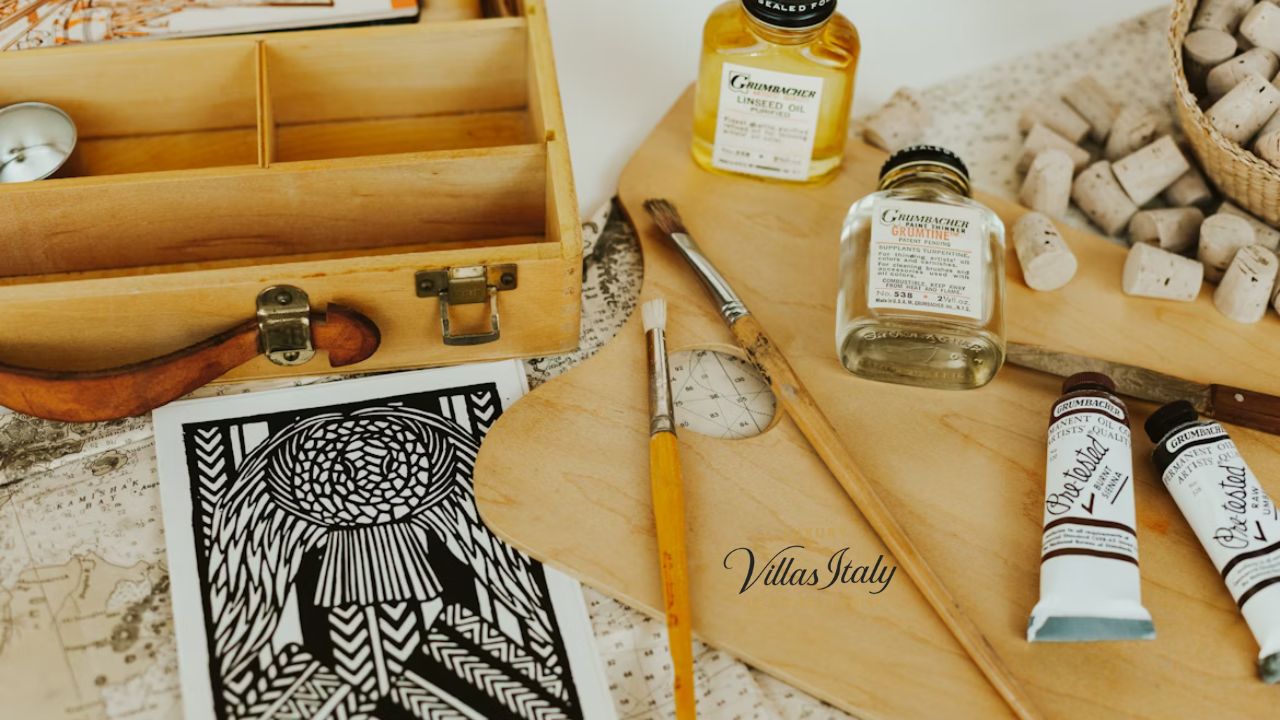Are you dreaming of a dedicated space where your creative spirit can run wild? The best craft room design ideas transform any space into an organized, inspiring sanctuary that fuels your artistic passion. Whether you’re working with a spacious room or a cozy corner, the right design approach can make all the difference in your crafting experience.
Creating the perfect craft room isn’t just about aesthetics—it’s about functionality, organization, and creating an environment that encourages creativity to flourish. From ingenious storage solutions to mood-boosting lighting, every element plays a crucial role in designing a space that truly works for you.
Essential Craft Room Design Elements Summary
| Design Element | Key Features | Average Cost | Impact Rating |
|---|---|---|---|
| Storage Systems | Modular shelving, drawer organizers, pegboards | $150-$800 | 9.5/10 |
| Work Surface | Large tables, adjustable height desks | $200-$1200 | 9.0/10 |
| Lighting | Task lighting, natural light, overhead fixtures | $100-$500 | 8.5/10 |
| Organization Tools | Labels, bins, compartment systems | $50-$300 | 8.0/10 |
| Inspiration Board | Cork boards, magnetic surfaces, display areas | $30-$150 | 7.5/10 |
| Seating | Ergonomic chairs, adjustable stools | $100-$600 | 8.0/10 |
Planning Your Dream Craft Space
Assessing Your Available Space
Before diving into specific craft room design ideas, you need to evaluate what you’re working with. Measure your space carefully and consider both horizontal and vertical storage opportunities.
Small spaces can be just as functional as large rooms with smart planning. A converted closet, spare bedroom corner, or even a section of your dining room can become a crafting haven.
Think about your crafting habits too. Do you prefer spreading out multiple projects simultaneously, or do you focus on one activity at a time?
Identifying Your Crafting Needs
Different crafts require different setups. Scrapbookers need flat surfaces and paper storage, while jewelry makers require good lighting and small compartment organization.
Make a list of your current hobbies and any you’d like to explore. This prevents you from creating a space that limits your creative growth.
Consider seasonal crafts too. Holiday decorating, gift-making, and outdoor projects might need temporary storage solutions.
Maximizing Storage in Your Craft Room
Vertical Storage Solutions
Wall-mounted storage is a game-changer for craft room design ideas. Install floating shelves at varying heights to accommodate different supplies.
Pegboards offer incredible versatility. You can rearrange hooks and accessories as your needs change, making them perfect for evolving craft collections.
Consider ceiling-mounted storage for lightweight, seasonal items. Overhead bins keep supplies accessible while freeing up valuable floor and desk space.
Modular Organization Systems
Drawer organizers transform chaotic supply drawers into efficient storage systems. Adjustable dividers let you customize compartments for various supplies.
Rolling carts provide mobile storage that can move where you need it. They’re particularly useful for supplies you use across multiple projects.
Clear storage containers are essential for maintaining visibility. When you can see everything, you’re more likely to use your supplies and less likely to buy duplicates.
Hidden Storage Opportunities
Ottoman storage benches serve double duty as seating and supply storage. They’re particularly useful in multipurpose rooms where craft supplies need to stay hidden.
Under-table storage maximizes every inch of your workspace. Hanging organizers, drawer units, and wire baskets can transform dead space into valuable storage.
Behind-door storage often goes overlooked. Install narrow shelving or hanging organizers on the backs of doors for frequently used supplies.
Creating Functional Work Surfaces
Primary Workspace Design
Your main work surface should accommodate your most frequent activities. A large, flat table works well for most crafts, but consider your specific needs.
Height matters more than you might think. Standard dining tables work for some crafters, while others benefit from adjustable-height surfaces.
Surface material affects both function and durability. Laminate surfaces wipe clean easily, while wood provides warmth but may require protection from adhesives and paints.
Specialized Work Areas
Consider creating dedicated zones for different activities. A cutting station with a self-healing mat serves quilters and paper crafters well.
A wet station with waterproof surfaces handles messy projects like painting or clay work. Include proper ventilation and easy cleanup features.
An assembly area with good lighting and comfortable seating works perfectly for detail work like jewelry making or model building.
Multi-Level Surfaces
Tiered work surfaces maximize functionality without requiring more floor space. A main table with raised shelving creates multiple working levels.
Adjustable surfaces adapt to different projects. Tilting drafting tables work beautifully for drawing and painting projects.
Pull-out surfaces provide additional workspace when needed but tuck away when not in use. They’re particularly valuable in smaller craft rooms.
Lighting Your Craft Space Effectively
Natural Light Optimization
Position your primary workspace near windows when possible. Natural light provides the most accurate color representation for many crafts.
Use sheer curtains or blinds to control harsh sunlight while maintaining brightness. Direct sunlight can create glare and heat issues.
Consider the direction your windows face. North-facing windows provide consistent, soft light throughout the day.
Task Lighting Solutions
Adjustable desk lamps target specific work areas without creating shadows. LED options provide bright, cool light that doesn’t generate heat.
Under-cabinet lighting illuminates work surfaces from above, reducing shadows and eye strain. Battery-operated options work well in spaces without convenient electrical access.
Magnifying lamps combine lighting with magnification for detailed work. They’re particularly valuable for jewelry making, electronics, or miniature crafts.
Ambient Lighting Design
Overhead lighting provides general illumination for your entire craft room. Choose fixtures that distribute light evenly without creating harsh shadows.
Track lighting offers flexibility to direct light where you need it most. Individual fixtures can be adjusted as your workspace layout changes.
String lights or decorative lamps add warmth and personality to your craft room. They create a cozy atmosphere that encourages longer crafting sessions.
Color Schemes That Inspire Creativity
Energizing Color Palettes
Bright, cheerful colors can boost energy and creativity. Yellow promotes mental clarity, while orange encourages enthusiasm and creativity.
Consider accent walls in bold colors rather than overwhelming your entire space. A single colorful wall can provide inspiration without becoming distracting.
Use color psychology to your advantage. Blues promote focus and calm, while greens reduce eye strain and create a sense of balance.
Calming Color Approaches
Neutral color schemes create versatile backgrounds that won’t compete with your colorful supplies. Whites, grays, and beiges provide clean, timeless backdrops.
Soft pastels offer color without overwhelming intensity. Pale blues, gentle greens, and warm creams create soothing environments conducive to concentration.
Monochromatic schemes use various shades of the same color family. This approach creates cohesion while allowing for visual interest through texture and pattern.
Flexible Color Solutions
Removable wallpaper or wall decals let you change your craft room’s personality without permanent commitment. Seasonal changes keep your space feeling fresh.
Colorful accessories and storage containers provide easy ways to introduce color. Swap them out when you want a new look or need a creative refresh.
Consider your craft supplies as part of your color scheme. Beautiful supplies displayed openly can serve as both storage and decoration.
Organization Systems That Actually Work
Labeling Strategies
Clear, consistent labeling prevents the frustration of searching for supplies. Use a label maker for professional-looking results, or create handwritten labels for a personal touch.
Photo labels work wonderfully for containers holding small parts. A picture shows exactly what’s inside without requiring you to read text.
Color-coded labels create visual organization systems. Assign different colors to various craft types or project phases for instant recognition.
Inventory Management
Keep track of your supplies to avoid overbuying and to know when you’re running low. Simple spreadsheets or crafting apps can help maintain inventory.
Regular decluttering sessions keep your organization systems functioning smoothly. Set aside time quarterly to assess what you use and what you can donate.
Create shopping lists based on your inventory system. This prevents impulse purchases and ensures you buy what you actually need.
Seasonal Organization
Rotate seasonal supplies to keep your everyday workspace uncluttered. Store holiday crafting materials in clearly labeled bins during off-seasons.
Create portable project kits for temporary crafting locations. This is especially useful during holidays when you might craft in different rooms.
Plan ahead for seasonal projects by preparing supplies in advance. This prevents last-minute scrambling and allows for better deals on materials.
Incorporating Technology in Craft Rooms
Digital Organization Tools
Crafting apps help track projects, organize patterns, and manage supplies. Many offer cloud storage for accessing information from anywhere.
Digital cameras document project progress and final results. This helps with tutorials, social media sharing, and personal memory keeping.
Tablets or smartphones provide instant access to tutorials, patterns, and inspiration. Mount them at comfortable viewing angles near your workspace.
Tech-Enhanced Storage
QR codes on storage containers link to detailed inventory lists or photos of contents. This high-tech labeling system works particularly well for small parts.
Smart storage solutions include app-controlled lighting and temperature monitoring for sensitive supplies. These aren’t necessary for everyone but add convenience for serious crafters.
Digital pattern storage eliminates paper clutter while keeping designs easily accessible. Cloud storage ensures patterns are never lost.
Communication and Sharing
Video calling capabilities let you craft with friends remotely. Many crafters enjoy virtual crafting sessions, especially when traveling isn’t possible.
Live streaming equipment enables sharing your crafting process with online communities. This has become increasingly popular among serious crafters.
High-quality cameras help document finished projects for portfolios, blogs, or social media sharing. Good lighting makes photography much easier.
Budget-Friendly Design Solutions
DIY Storage Projects
Repurpose household items for craft storage. Mason jars, tin cans, and egg cartons make excellent organizers for small supplies.
Build simple shelving using basic lumber and brackets. This costs significantly less than buying pre-made storage systems.
Create custom organizers using cardboard and decorative paper. While not as durable as commercial options, they’re perfect for trying out organization ideas.
Thrift Store Treasures
Old furniture pieces can become excellent craft storage with minimal modification. Dressers, bookcases, and filing cabinets often work perfectly.
Vintage sewing boxes and jewelry boxes provide charming storage for small supplies. Their compartments are often perfect for craft materials.
Kitchen items like spice racks, utensil holders, and containers frequently work well for craft supply organization.
Gradual Implementation
Build your craft room over time rather than trying to create everything at once. This spreads costs and allows you to learn what works best.
Start with essential elements and add convenience features later. A basic workspace and storage system can be enhanced over time.
Watch for sales and clearance items to build your craft room affordably. Stock up on storage containers and organizational supplies when prices are low.
Multi-Purpose Room Considerations
Shared Space Strategies
When your craft room shares space with other functions, create portable organization systems. Rolling carts and carrying totes make setup and cleanup manageable.
Use room dividers or curtains to define your crafting space within a larger room. This creates psychological boundaries even when physical walls don’t exist.
Choose furniture that serves multiple purposes. A dining table can double as a craft table, while storage ottomans provide seating and supply storage.
Quick Setup Solutions
Design systems that allow rapid deployment of your crafting supplies. Everything should have a designated place and be easy to access quickly.
Create project kits that contain everything needed for specific activities. This eliminates the need to gather supplies each time you want to craft.
Use vertical storage solutions that don’t interfere with the room’s primary function. Wall-mounted systems work particularly well in shared spaces.
Family-Friendly Features
If children will use the space, ensure supplies are stored safely and age-appropriately. Lower shelves can hold child-safe materials while potentially dangerous items stay up high.
Create designated areas for different family members’ projects. This prevents mixing of supplies and allows everyone to maintain their organization systems.
Consider washable surfaces and easy-cleanup features when family crafting is part of the plan. Messes are inevitable with multiple users.
Inspiration and Display Areas
Showcasing Finished Projects
Create dedicated display areas for your completed works. This provides motivation and lets you enjoy the fruits of your creative labor.
Rotate displays regularly to keep your space feeling fresh. Store non-displayed items safely to prevent damage.
Consider lighting your display areas to highlight your work properly. Small spotlights or picture lights can make displays more dramatic.
Inspiration Boards
Pin boards, magnetic surfaces, or wire grids provide places to display inspiration, patterns, and work-in-progress photos. Change these regularly to keep ideas flowing.
Digital displays can cycle through inspiration images automatically. Tablets or digital picture frames work well for this purpose.
Create themed inspiration areas for different types of projects. This helps maintain focus when working on specific craft types.
Project Planning Spaces
Dedicate wall space or a bulletin board for project planning. Include calendars, supply lists, and step-by-step guides for current projects.
Use dry-erase boards for temporary notes and sketches. They’re perfect for working through design ideas without wasting paper.
Create templates for common planning needs like supply lists, measurements, or project timelines. This saves time and ensures you don’t forget important details.
Ergonomic Considerations for Long Crafting Sessions
Seating Solutions
Invest in a quality chair that supports good posture during long crafting sessions. Your back, neck, and shoulders will thank you.
Adjustable height seating allows you to match your chair to your work surface perfectly. This reduces strain and increases comfort.
Consider multiple seating options for different activities. A tall stool works well for standing-height cutting tables, while a comfortable chair suits detailed desk work.
Workstation Ergonomics
Position your work surface at a comfortable height to prevent hunching or reaching. Your elbows should bend at roughly 90 degrees when working.
Place frequently used supplies within easy reach to minimize stretching and twisting. This is particularly important for items you use repeatedly.
Take regular breaks to stand, stretch, and rest your eyes. Set timers if necessary to remind yourself to move periodically.
Tool Organization for Easy Access
Arrange tools in the order you use them to minimize repetitive reaching. This is particularly important for assembly-line type activities.
Use tool holders that keep implements easily accessible without causing clutter. Magnetic strips work well for metal tools, while containers with compartments organize various implements.
Consider the weight and frequency of use when positioning supplies. Heavy items should be stored at waist level, while frequently used supplies deserve prime real estate.
Ventilation and Safety Features
Air Quality Management
Ensure adequate ventilation, especially if you use adhesives, paints, or other materials with fumes. Open windows when possible, and consider exhaust fans for enclosed spaces.
Air purifiers can help remove particles and odors from your craft room air. This is particularly important for those with allergies or respiratory sensitivities.
Store chemicals and solvents properly according to manufacturer instructions. Many require cool, dry storage away from heat sources.
Fire Safety Precautions
Keep appropriate fire extinguishers accessible, especially if you use heat tools or flammable materials. Know how to use them properly.
Install smoke detectors in your craft room and check batteries regularly. Early warning can prevent small problems from becoming disasters.
Create clear escape routes and keep them unobstructed. While accidents are rare, preparation is always wise.
First Aid Readiness
Keep a well-stocked first aid kit easily accessible in your craft room. Include items specific to your crafting activities, like tweezers for splinter removal.
Know basic first aid procedures for common crafting injuries like cuts, burns, and eye irritation. Quick response can prevent minor injuries from becoming serious.
Keep emergency contact information posted where you can easily find it. This includes poison control numbers if you use potentially hazardous materials.
Seasonal and Holiday Crafting Considerations
Flexible Storage for Seasonal Items
Plan storage solutions that accommodate seasonal fluctuations in supplies. Holiday crafting often requires temporary storage for large quantities of materials.
Use clear, labeled bins to store seasonal supplies. Stack them efficiently during off-seasons while keeping labels visible for easy identification.
Consider climate-controlled storage for sensitive seasonal materials. Heat and humidity can damage papers, fabrics, and other materials over time.
Temporary Workspace Expansion
Plan for times when you’ll need additional workspace for large projects. Folding tables can expand your work surface when needed.
Create systems for protecting other areas when crafting expands beyond your designated space. Drop cloths and protective coverings prevent damage to floors and furniture.
Develop efficient setup and breakdown procedures for expanded crafting sessions. This makes it more likely you’ll take on larger projects when inspiration strikes.
Gift-Making Organization
Create dedicated storage for works in progress destined as gifts. Keep these separate and hidden from intended recipients.
Plan ahead for gift-giving seasons by starting projects early. This reduces stress and allows for better quality work.
Keep gift wrapping supplies organized and accessible. Include cards, ribbons, tags, and wrapping paper in your craft room if space allows.
Technology Integration for Modern Crafters
Digital Pattern and Tutorial Access
Set up reliable internet access in your craft room for streaming tutorials and accessing online patterns. This has become essential for modern crafting.
Consider larger screens for better visibility of detailed tutorials. Mounting tablets or small televisions at eye level reduces neck strain.
Create bookmarks and organize digital resources just as carefully as you organize physical supplies. Digital clutter can be just as problematic as physical clutter.
Social Media and Documentation
Good lighting and backgrounds make photographing your work easier. Consider this when planning your craft room layout.
Create designated areas for photographing finished projects. Consistent backgrounds and lighting improve your social media posts and project documentation.
Plan space for any equipment you use for content creation, such as tripods, ring lights, or streaming equipment.
Online Community Participation
Many crafters enjoy participating in online challenges and virtual craft-alongs. Ensure your space accommodates the documentation these often require.
Consider acoustics if you plan to participate in video calls or create audio content. Hard surfaces can create echo, while soft furnishings absorb sound.
Plan for the technology learning curve. What starts as simple photo sharing might evolve into video tutorials or live streaming.
Maintenance and Evolution of Your Craft Room
Regular Maintenance Schedules
Establish routine cleaning schedules to keep your craft room functional and inspiring. Daily pickup, weekly organization, and monthly deep cleaning work well for most crafters.
Plan periodic organization reviews to adjust systems as your needs change. What works initially might need modification as your crafting evolves.
Budget for replacement and upgrade of organizational systems over time. Wear and changing needs make periodic updates normal and necessary.
Adapting to Changing Interests
Design flexible systems that can adapt as your crafting interests evolve. Modular storage and adjustable features accommodate changing needs better than fixed solutions.
Plan for growth in your craft room design. Leave some empty space and unused organizational capacity for future expansion of interests or supplies.
Consider resale value and adaptability when making permanent changes. Future owners might have different needs, and you might move someday.
Documentation and Improvement
Keep photos of your craft room organization as it evolves. This helps you remember what worked and what didn’t when making future changes.
Note what supplies you actually use versus what you thought you’d use. This information guides future purchases and storage planning.
Share successful ideas with other crafters and learn from their experiences. The crafting community is generous with organizational inspiration and advice.
Frequently Asked Questions
What’s the minimum space needed for a functional craft room?
You can create a functional crafting space in as little as 25 square feet. A corner of a bedroom, converted closet, or section of a dining room can work beautifully with smart design choices. The key is vertical storage and multi-functional furniture that maximizes every inch.
How much should I budget for setting up a basic craft room?
A basic craft room setup can cost anywhere from $500 to $2,000, depending on your space size and needs. Essential elements include a work surface ($200-$400), storage solutions ($200-$600), lighting ($100-$300), and seating ($100-$400). You can significantly reduce costs by repurposing existing furniture and shopping secondhand.
What’s the most important element in craft room design ideas?
Storage is consistently rated as the most crucial element by crafters. Without proper organization, even the most beautiful craft rooms become unusable chaos. Focus on creating storage systems that keep supplies visible, accessible, and organized before investing in decorative elements.
How do I organize craft supplies when I have multiple hobbies?
Create zones for different activities within your space, even if they’re small. Use portable storage containers that can be easily moved and swapped out. Label everything clearly and consider color-coding systems for different craft types. Rolling carts work excellently for multi-hobby crafters.
What lighting works best for detailed craft work?
Combine natural light with task lighting for the best results. Position your workspace near a window if possible, then add adjustable LED desk lamps with at least 1000 lumens for detailed work. Avoid fluorescent lights, which can cause eye strain and color distortion.
How do I keep my craft room organized long-term?
Establish daily cleanup routines and stick to them. Put supplies back in designated spots immediately after use. Schedule weekly organization sessions and monthly deeper cleanings. Most importantly, resist the urge to acquire supplies just because they’re on sale unless you have immediate plans to use them.
Can I create a craft room on a tight budget?
Absolutely! Start with basics like a table and some storage containers, then build gradually. Shop thrift stores, repurpose household items, and take advantage of sales. DIY storage solutions using cardboard, mason jars, and basic lumber can be very effective and inexpensive.
How do I choose between open shelving and closed storage?
Use a combination of both. Open shelving works well for frequently used supplies and pretty items that inspire you. Closed storage is better for supplies that create visual clutter, seasonal items, or materials that need protection from dust and light. Aim for about 70% closed storage and 30% open display.
Creating the perfect craft room is a journey, not a destination. Start with the basics—good lighting, adequate storage, and a comfortable work surface—then build from there. Remember that the best craft room design ideas are the ones that work for your specific needs, space, and budget. Your creative sanctuary should inspire and support your artistic endeavors while being practical enough to maintain long-term.
The most successful craft rooms evolve over time as their owners discover what works and what doesn’t. Don’t feel pressured to create perfection immediately. Instead, focus on functionality first, then add beauty and personal touches as your space develops. With thoughtful planning and gradual implementation, you can create a craft room that truly sparks creativity and brings joy to your artistic pursuits.
Admin Recommendation
Luxury Villas in Greece: Discover Le Collectionist’s Exclusive Retreats
Luxury Villas Italy Le Collectionist: A Dream Worth Indulging












